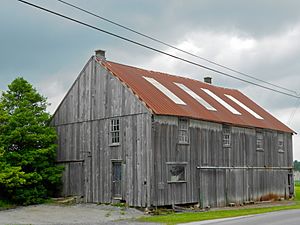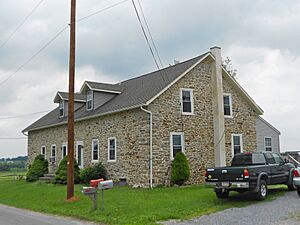Nickel Mines, Pennsylvania facts for kids
Quick facts for kids
Nickel Mines, Pennsylvania
|
|
|---|---|

Barn in town
|
|
| Country | United States |
| State | Pennsylvania |
| County | Lancaster |
| Township | Bart |
| Area | |
| • Total | 0.38 sq mi (0.98 km2) |
| • Land | 0.38 sq mi (0.98 km2) |
| Population
(2010)
|
|
| • Total | 35 |
| • Estimate
(2016)
|
32 |
| • Density | 92.5/sq mi (35.7/km2) |
| Time zone | UTC-5 (Eastern (EST)) |
| • Summer (DST) | UTC-4 (EDT) |
| ZIP codes |
17562
|
| Area code(s) | 717 |
| GNIS feature ID | 1182445 |
Nickel Mines is a small community, called a hamlet, located in Bart Township, Lancaster County, Pennsylvania, United States. The area's zip code is 17562, and its area code is 717. Today, Nickel Mines is home to a large Amish community.
Contents
History of Nickel Mines
The town of Nickel Mines gets its name from the nickel mines that once operated there. These mines dug up a type of rock called sulfide ore, which mainly contained a mineral called millerite. The mines first opened in the early 1700s to find copper. However, they were not very successful at finding copper, so they were eventually closed.
Discovering Nickel in the Mines
In 1849, a company called Gap Mining tried to mine for copper again. They didn't find much copper, but in late 1852 or early 1853, they made an exciting discovery: nickel! Before this, people had mistakenly thought the ore was iron sulfide. To support the growing mining community, an Episcopal Church was built in 1857.
Joseph Wharton and Nickel Production
Gap Mining continued to extract nickel until 1860, when they stopped because it wasn't making enough money. In late 1862, they sold the mine to Joseph Wharton. Between 1862 and 1893, a huge amount of nickel was taken from the site – about 4.5 million pounds! In some years, this accounted for as much as 25% of all the nickel produced in the world.
Wharton processed the nickel in Camden, New Jersey. He was the first person in the industry to produce nickel that could be easily shaped. He also played a big part in convincing the United States Mint to create the first five-cent nickel coins in 1866. These coins used nickel that came from his very own mines.
Life in the Mining Town
By 1883, the town of Nickel Mines was quite developed. It included the superintendent's large house, 23 homes for the miners, a store with a living area, and five other buildings.
The End of Mining
The nickel mine closed down in 1893. This happened because new nickel mines in Sudbury, Ontario, Canada, offered strong competition. Today, you won't find any traces of the old mines, except for a few piles of waste rock. The area is now completely used for farming.
Population Information
| Historical population | |||
|---|---|---|---|
| Census | Pop. | %± | |
| 1990 | 30 | — | |
| 2000 | 43 | 43.3% | |
| 2010 | 35 | −18.6% | |
| 2016 (est.) | 32 | −8.6% | |
As of 2016, there were 16 households in Nickel Mines.




